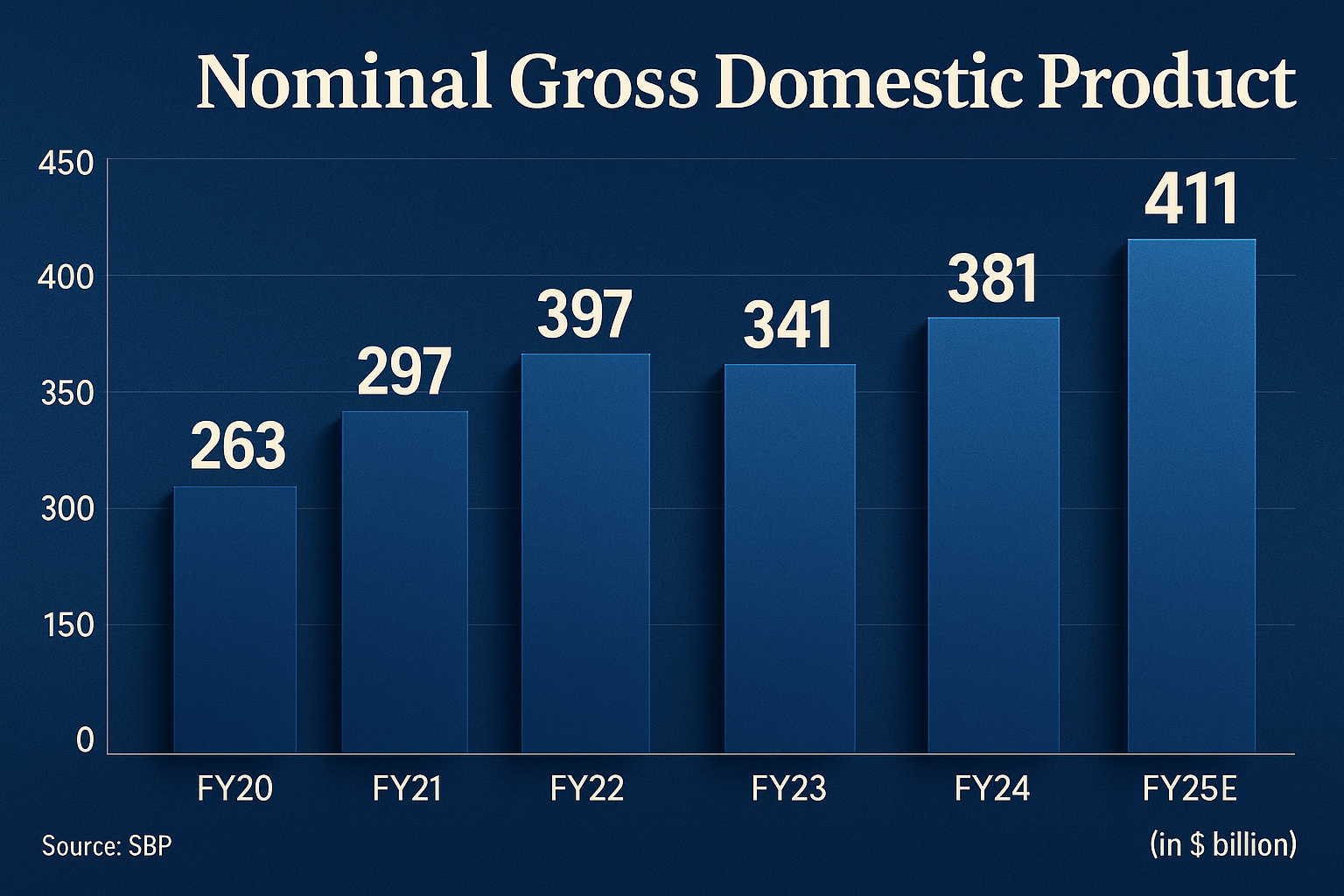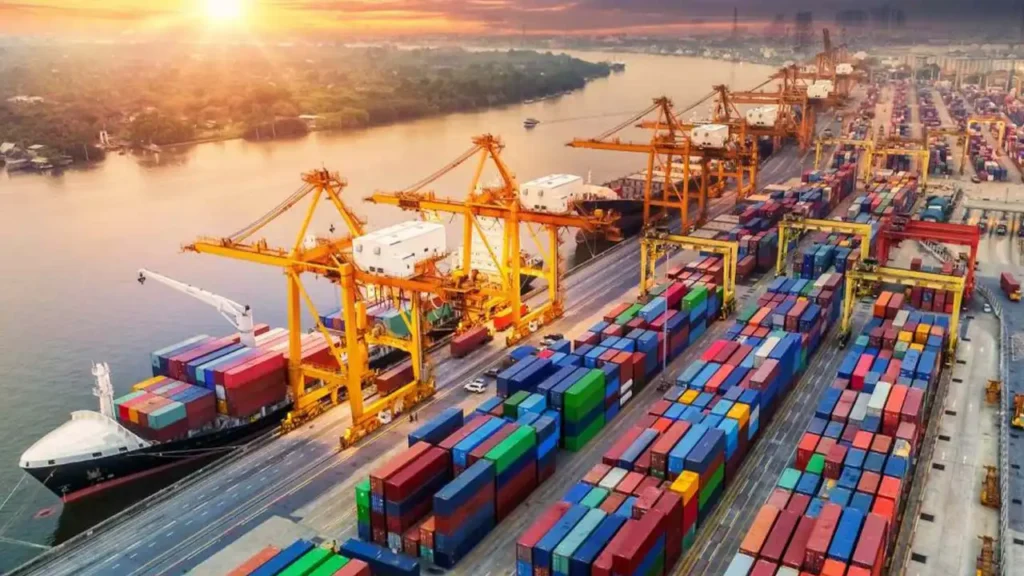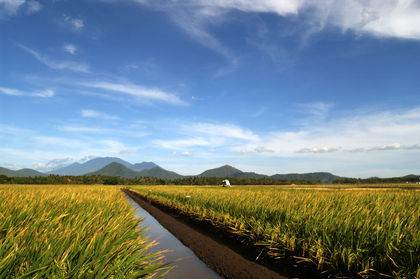A Major Milestone:
In a significant economic breakthrough, Pakistan’s Gross Domestic Product (GDP) has officially crossed $400 billion in 2025. This milestone reflects a major recovery and progress in the country’s economy, strengthening its image in the global financial community. now Pakistan GDP is 411 Billion US dollar and GDP per capita is 1,824 US dollar. 40 in position in world as per 2025 Pak Economy survey .

How Did Pakistan Achieve This Growth?
Several factors have contributed to this economic improvement:
-
Reforms in the tax system:
- Budget 2025 must pursue bold, equitable reforms to raise Rs. 36 trillion in revenue by ending regressive taxes, expanding the base, and simplifying Pakistan’s tax system for inclusive economic growth.In 2025, Pakistan is focusing on tax reforms to address key challenges and boost economic growth, including efforts to broaden the tax base, simplify tax laws, and improve tax administration. These reforms aim to increase tax revenue, enhance equity, and create a more stable and competitive business environment.
Government Policies:
The government’s recent economic policies and structural reforms have helped create a more favorable environment for both local and foreign investors.
According to recent reports, the Pakistani government’s economic policies and structural reforms have played a key role in stabilizing the economy and creating a more favorable environment for both local and foreign investors, with projected moderate growth of around 2.5% to 2.7% in the fiscal year 2025.
-
Fiscal Consolidation:
The government has implemented measures to reduce the budget deficit and improve fiscal stability, which has helped to build confidence among investors.
-
Monetary Policy Adjustments:
The central bank has lowered interest rates to stimulate economic activity and encourage investment, while also maintaining macroeconomic stability.
-
Structural Reforms:
The government has undertaken reforms in various sectors, including energy, taxation, and business regulations, to improve efficiency and attract investment.
-
Focus on Stability and Recovery:
The current focus is on stabilizing the economy and rebuilding confidence following a period of challenges, with a gradual transition towards sustainable and inclusive growth.
-
Challenges remain:
Despite positive progress, Pakistan still faces challenges such as high inflation, unemployment, and limited access to quality education and healthcare.
-
Sustainability of Reforms:
The long-term success of these policies will depend on their continued implementation and adaptation to evolving circumstances.
-
Focus on Inclusive Growth:While economic growth is important, the government needs to ensure that the benefits of these reforms are shared equitably across different segments of society.
-
Increase in exports:
-
In the first ten months of the fiscal year 2024-25 (July-April), Pakistan’s exports saw a 6.25% increase, reaching $26.859 billion, compared to $25.278 billion in the same period last year. Specifically, exports increased by 9.85% in the first nine months of the same fiscal year, reaching $6.24 billion. This growth is driven by various factors, including increased demand for textile products, especially knitwear and garments, and a surge in cement exports. However, some sectors like raw cotton and cotton yarn experienced negative growth.

pakistan-export. Key Observations:-
Overall Growth:
Pakistan’s exports have shown a positive trend, with a 6.25% increase in the first ten months of FY2025.
-
Textile Exports:
Textile exports, particularly knitwear, readymade garments, and bed wear, have seen significant increases.
-
Cement Exports:
Cement exports have also surged, indicating a robust construction sector.
-
Commodity-Specific Growth:
While overall exports are up, some specific commodities like raw cotton, cotton yarn, and cotton carded or combed have experienced a decrease in exports.
-
Services Exports:
Services exports have also seen growth, with a 9.85% increase in the first nine months of FY25.
Factors Contributing to the Increase:-
Increased Demand:
Global demand for Pakistani goods, particularly textiles, has likely contributed to the growth.
-
Government Initiatives:
Government policies aimed at promoting exports and improving the business environment may also be playing a role.
-
Stronger Cement Exports:
The surge in cement exports suggests a healthy construction sector, potentially driven by infrastructure projects.
Potential Challenges:-
Fluctuations in Commodity Prices:
Changes in global commodity prices, particularly for raw materials like cotton, can impact export values.
-
Trade Imbalances:
While exports are increasing, imports are also rising, leading to a trade deficit.
-
Political and Economic Instability:Political and economic instability within Pakistan can potentially hinder export growth.
-
-
Stabilization of foreign exchange reserves:
Pakistan forex reserve jump by 16.1 billion US dollar after IMF financial support , international monitoring fund IMF funded 1 billion dollar for pakistan in last 2 weeks during Pak India crisis . which show a potential growth in pakistan foreign exchange reserve .
According to data released by the State Bank of Pakistan (SBP) on Thursday, total foreign exchange reserves stood at $16.649 billion as of May 16, 2025, compared to $15.614 billion a week earlier, marking an increase of $1.034 billion. The SBP’s own reserves rose to $11.447 billion, up from $10.403 billion, reflecting a $1.043 billion week-on-week gain and reaching their highest level in four months.
The rise comes on the back of the IMF’s disbursement of SDR 760 million (approximately $1.023 billion) on May 13 under the Extended Fund Facility (EFF) program. The tranche is the second under the newly signed 37-month, $7 billion EFF agreement, which was finalized earlier this year to stabilize Pakistan’s economy amid rising external and fiscal pressures. While the SBP’s reserves saw a notable uptick, net reserves held by commercial banks saw a marginal decline of $9 million, bringing their total to $5.202 billion.
-
Growth in agriculture, industry, and IT sector:
Agriculture Growth:
In 2025, the agricultural sector in Pakistan experienced a growth of 0.56%. This growth was largely due to livestock, which saw a significant increase of 6.51% in the second quarter of the fiscal year. However, crop production, particularly wheat, cotton, maize, rice, and sugarcane, experienced a decline, with a contraction of 13.49% in important crops.

-
Overall Growth:
The agriculture sector’s growth of 0.56% in FY25 was a significant drop from previous years, indicating a period of challenges for the sector.
-
Livestock Performance:
Despite the overall decline, the livestock subsector performed exceptionally well, growing by 6.51% in Q2FY25, the highest in the past decade.
-
Crop Sector Decline:
Major crops experienced a downturn, with wheat production projected to fall by 8.91%, maize by 15.4%, rice by 1.38%, sugarcane by 3.88%, and cotton by 30.7%.
-
Other Crops:
Some other crops, like potatoes, onions, mangoes, and sesame, saw positive growth, potentially offsetting some of the decline in the main crops.
-
Factors Affecting Growth:
Factors such as adverse weather conditions and pest infestations have been cited as contributing to the limited growth in agriculture.
-
Government Initiatives:
The government has launched initiatives like the Green Pakistan Initiative to revitalize agriculture through corporate farming and technology.
-
Future Prospects:While livestock has shown resilience, the challenges in crop production raise concerns about the long-term sustainability of the agricultural sector.
Industry Growth:
In 2025, the industry sector in Pakistan is projected to experience a provisional growth of 4.77%, despite some challenges in specific sub-sectors like mining and quarrying. Overall, the Pakistani economy is expected to grow at a slower-than-expected pace of around 2.6-2.8%.

-
Overall Growth:The industry sector, as a whole, is expected to grow by 4.77%.
-
Mining and Quarrying:This sub-sector experienced a contraction of 3.38%, primarily due to declines in natural gas, crude oil, and other mineral production.
-
Large-Scale Manufacturing:While coal production saw a rise, the Large-Scale Manufacturing sector, as measured by the Quantum Index of Manufacturing (QIM), experienced a decline of 1.53%.
-
Electricity, Gas, and Water:This sector saw a significant increase of 28.88%, largely due to a low base effect from the previous fiscal year.
-
Construction:The construction sector recorded a rise of 6.61%, driven by increased private and government spending on construction-related activities.
IT Sector:
Digital growth in Pakistan is going through a rapid evolution. IT/ITeS Sector is one of the fastest growing sectors of Pakistan contributing about 1% of GDP of Pakistan at about 3.5 billion USD. It doubled in the past four years and experts expect it to grow a further 100% in the next two to four years to $7 billion.

Significant Increase in GDP Per Capita
According to the World Bank and Pakistan Bureau of Statistics, the country’s GDP per capita has also shown improvement, now reaching $1,824. This indicates better income distribution and an overall uplift in living standards.
Pakistan’s Current Economic Indicators (2025)
| Indicator | 2025 Data |
|---|---|
| GDP | $400+ billion USD |
| GDP Per Capita | $1,824 USD |
| Economic Growth Rate | 3.6% (Projected) |
| Inflation Rate | 12% (Under Control) |
| Foreign Reserves | $9.5 billion USD |
| Current Account Deficit | Reduced to $1.2 billion USD |
What’s Next for Pakistan’s Economy?
To sustain and further this growth, Pakistan needs to focus on:
-
Improving education and vocational training
-
Attracting long-term investment
-
Reforming the energy sector
-
Boosting the IT and startup ecosystem
Sustained efforts in these areas will not only stabilize the economy but also provide long-term opportunities for growth and employment.
https://muavpk.com/pakistan-budget-2025-26/
https://muavpk.com/pl-15-air-to-air-missile-10-amazing-facts/#4_Uses_Active_Radar_Homing
https://www.facebook.com/share/1AbLcQwDfj/
CTA:
Stay Informed. Stay Ahead.
If you’re looking for reliable, research-backed updates on Pakistan’s economy, politics, world affairs, and history, follow Muav PK now!
🔗 Visit: muavpk.com
📢 Truth. Research. Awareness. Only at Muav PK.
FAQs:
Q: When did Pakistan’s GDP cross $400 billion?
A: In the first quarter of 2025, Pakistan’s GDP officially surpassed $400 billion.
Q: What does GDP mean?
A: GDP (Gross Domestic Product) represents the total market value of all goods and services produced in a country over one year.
Q: What is GDP per capita?
A: It is the average income per person in a country, calculated by dividing total GDP by the population.
Q: Is Pakistan’s economy now stable?
A: While there is positive growth, complete stability will require consistent reforms and long-term strategies.

3 thoughts on “Shocking Comeback of Pakistan’s Economy 2025: GDP Crosses $400 Billion & Per Capita Income Rises”